Are Down Pillows Washable? A Comprehensive Guide
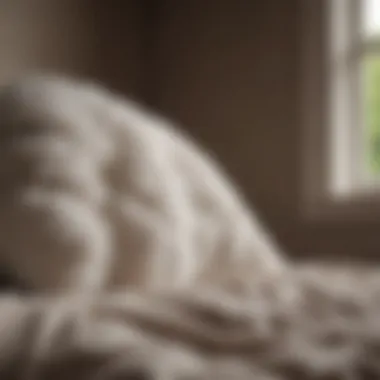
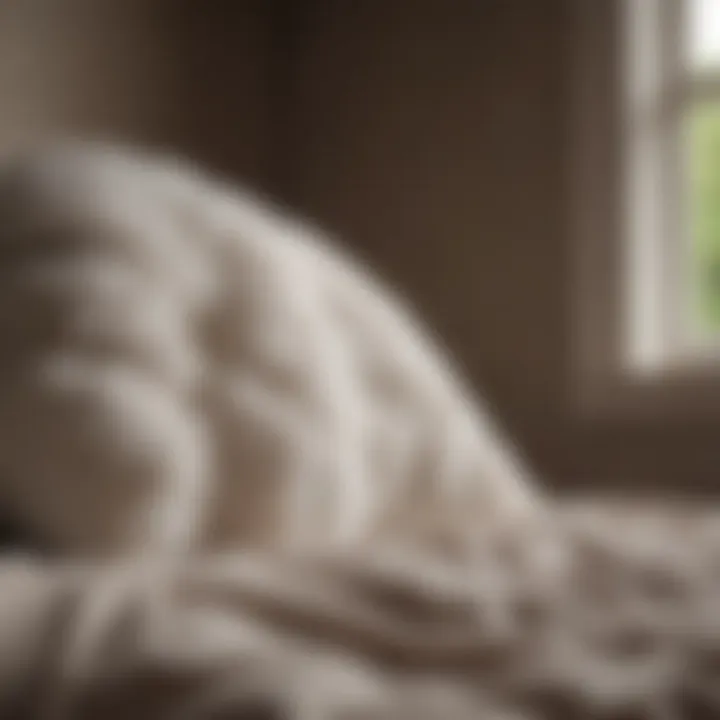
Intro
Understanding the care and maintenance of down pillows is vital for any homeowner or interior design enthusiast. This guide will address a key question: Are down pillows washable? While they provide exceptional comfort and insulation, their maintenance requires specific knowledge and methods. Down pillows can last for many years, but improper cleaning can lead to a decrease in their performance and longevity.
Here, we will explore the types of down materials used, discuss relevant fabric considerations, and provide detailed washing instructions. It’s important to note that not all down pillows are treated equally; some may require more gentle care than others. Being informed can help you ensure your down pillows remain comfortable and hygienic over time.
Understanding Down Materials
Down is the soft layer of fluff found beneath the feathers of ducks and geese. It is essential to differentiate between types of down—such as goose down and duck down—because both can behave differently during cleaning.
- Goose Down: Generally offers higher loft and insulation.
- Duck Down: Often more affordable but may have a slightly heavier feel.
When considering to wash your down pillows, also look for specific labels or tags that provide guidelines. Pillow types can range from 100% down to down blends, and these variations can affect how you should approach washing.
Fabric Considerations
The outer shell of down pillows often comprises various materials like cotton, polyester, or a blend. Knowing the fabric helps determine the washing method:
- Cotton: Typically durable and breathable, can usually withstand standard washing.
- Polyester: More water-resistant but may require specific care.
Each fabric type can react differently to washing. It is advisable to always check the care label before proceeding with any cleaning methods.
Washing Instructions
To achieve effective cleaning without damaging your pillows, follow this step-by-step guide.
- Check Care Tag: Always start with the care instructions provided.
- Use a Large Capacity Washer: A front-loading machine is preferable to avoid agitation that could harm the down filling.
- Select Gentle Cycle: Use warm water and a mild detergent—avoid any bleach or fabric softeners.
- Add Tennis Balls: Including a few clean tennis balls during the wash and dry cycles helps prevent clumping.
- Rinse Thoroughly: Ensure all detergent is removed to maintain the down's integrity.
- Dry with Care: Use a low heat setting and check often to ensure they don’t overheat. Drying can take a few cycles.
Final Thoughts
Knowing if your down pillows are washable and how to maintain them is key to achieving long-lasting comfort. As we explore further, this guide will help you grasp seasonal maintenance and cleaning practices.
By understanding the right methods for your specific pillows, you can maintain their softness and structure, providing you with a restful night’s sleep for years to come.
Intro to Down Pillows
Down pillows offer a unique combination of comfort and support, making them a preferred choice for many individuals seeking quality sleep. They provide a soft, plush feel, essential for creating a luxurious sleeping environment. Understanding the nature of down pillows is crucial for maintaining their longevity and performance. This article discusses the importance of proper care, specifically focusing on the washability of these pillows.
One significant element to consider is the type of down material used. Down varies in source, including goose and duck, impacting both the feel and durability of the pillow. Different fill powers indicate how well the pillow will retain its shape and loft. It’s essential to know what type of down you have, as this affects cleaning methods and care instructions.
Another vital aspect is the fabric cover. Common materials like cotton and polyester not only play a role in the feel of the pillow but also influence how easily the pillow can be washed. High-quality fabric might withstand washing better, while lower-quality options may wear out quickly.
Moreover, the benefits of washing down pillows extend beyond mere hygiene. Regular cleaning helps to maintain fluffiness and freshness, contributing to a better sleep experience. On the other hand, neglecting to care properly for your down pillows may lead to clumping or loss of shape.
In summary, knowing how to properly maintain and wash down pillows is essential. It ensures that they remain a viable and comfortable option for years. Attention to materials, types, and care procedures is the first step toward achieving this goal.
Understanding Down Material
Understanding the material used in down pillows is crucial for several reasons. Knowledge of down materials helps consumers make informed purchasing decisions and care choices. It also impacts the overall comfort, durability, and washability of the pillows. Different types of down offer distinct benefits, making it essential to understand each one.
What is Down?
Down is a soft layer of fine feathers found beneath the tougher exterior feathers of birds. It acts as insulation, providing warmth and comfort. Down is primarily sourced from geese and ducks, with variations in quality, softness, and warmth.
The characteristics of down include its ability to trap air, which leads to warmth while still remaining lightweight. Given its unique properties, down is highly valued in bedding and outdoor gear. For pillows, down offers a plush feel that few other materials can match, making it a popular choice among consumers.
Types of Down Used in Pillows
Understanding the different types of down helps in selecting the right pillow. Here are the main types:
Goose Down
Goose down is often considered the premium choice in the down pillow market. One key characteristic of goose down is its larger cluster size compared to duck down. Larger clusters mean better insulation and support, which leads to a luxurious feel.
In this article, goose down is beneficial because it provides superior warmth without adding extra weight. The unique feature of goose down is its high fill power, which refers to the amount of space one ounce occupies. The higher the fill power, the more air trapped, which leads to greater warmth and puffiness. However, goose down can be more expensive than other options.
Duck Down
Duck down represents a more economical option compared to goose down. One of its main characteristics is that it often has a smaller cluster size. Duck down tends to be less lofty, which means it is not as warm or fluffy as goose down.
It remains a popular choice due to its affordability. A unique feature of duck down is that it can be found in more varied qualities. While it might not hold its shape as well as goose down, it can still provide adequate comfort. However, depending on the quality, it may require more frequent replacement.
Synthetic Down Alternatives
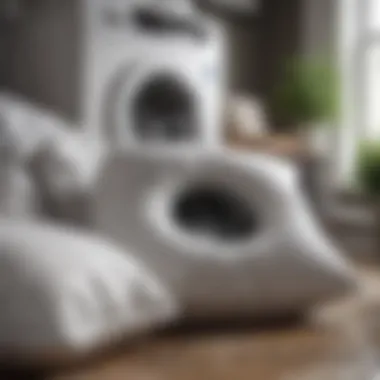

Synthetic down alternatives are made from polyester materials designed to mimic natural down. This material is increasingly popular for various reasons. One key characteristic of synthetic down is its hypoallergenic nature, making it suitable for people with allergies.
Synthetic down is a beneficial choice because it is generally easier to care for, often being machine washable and more resilient against moisture. A unique feature is its affordability and durability. On the downside, it may not provide the same level of insulation or luxurious feel that natural down offers.
Understanding the composition of down and its alternatives helps in making informed decisions about pillow care as well as purchase, ensuring comfort and longevity.
Fabric Considerations
When considering the care and washability of down pillows, the choice of fabric cannot be overlooked. The fabric encasing the down material plays a crucial role in protection, breathability, and overall durability. Factors such as the origin, texture, and quality of the fabric can impact both the comfort and functionality of the pillow.
Different fabrics offer varying degrees of softness, water resistance, and ease of cleaning. Understanding these elements helps in making informed decisions about pillow maintenance and longevity. Selecting a high-quality external fabric can enhance down pillows' performance, ensuring they remain hygienic and comfortable over time.
Common Fabrics for Down Pillows
Cotton
Cotton is a widely used fabric for down pillows, mainly due to its breathability and softness. It allows for proper airflow, which is essential for temperature regulation while sleeping. A key characteristic of cotton is its natural composition. This makes it more hypoallergenic compared to synthetic materials, making it a beneficial choice for allergy sufferers.
One unique feature of cotton is its ability to absorb moisture, helping to keep pillows dry and comfortable. However, it may require more frequent washing to prevent dirt buildup.
Polyester
Polyester, a synthetic fabric, is often selected for its durability and resistance to wrinkles and fading. It can provide a smooth texture and is generally easier to care for than natural fibers. The key characteristic of polyester is its strong resistance to stains, which can be advantageous in maintaining the pillow's appearance.
A unique feature of polyester is that it dries quickly, reducing the time needed for care and maintenance. However, it may not provide the same level of breathability as cotton, which can lead to heat retention in some situations.
Silk
Silk is considered a luxurious option for down pillows, known for its softness and sheen. Its smooth surface can provide a gentle sleeping experience, minimizing friction on the skin and hair. The key characteristic of silk is its natural temperature-regulating properties, which can help maintain comfort throughout the night.
A unique advantage of silk is its hypoallergenic nature, making it suitable for sensitive individuals. However, silk may require more careful washing and is generally more expensive than other fabrics, which can be a consideration for potential buyers.
Importance of Fabric Quality
The quality of fabric used for down pillows significantly impacts their overall performance. Higher quality fabrics can enhance durability, comfort, and maintain significantly better hygiene levels. Investing in good fabric means less frequent replacement and potentially better sleep experiences. Quality fabrics also resist wear and tear, ensuring that the investment lasts longer, decreasing unnecessary waste and promoting sustainability.
Furthermore, good fabric quality can also affect the washability of the pillows. Pillows made from sturdy, high-quality materials are likely to hold up better through multiple washing cycles.
Choosing the right fabric can extend the lifespan of your down pillows and enhance your sleeping experience.
Check the Care Label
When it comes to maintaining the integrity and lifespan of down pillows, the care label is a crucial element. This small tag provides essential information on how to properly clean and care for the pillow, ensuring that your investment in comfort does not lead to premature wear or damage. Ignoring these instructions can result in significant issues such as clumping, loss of loft, or even irreparable damage to the filling. Therefore, it is imperative to familiarize yourself with the care label as it offers guidance tailored to your specific pillow model.
Understanding Care Symbols
Care symbols on pillow tags can sometimes seem cryptic, but they are designed to simplify the cleaning process. Different symbols indicate the recommended washing, drying, and ironing practices. For instance, a washing machine symbol typically indicates that the pillow can be machine washed at a specific temperature. Look for additional notes on drying processes as well, since not all down pillows will respond well to high heat.
Here are common care symbols you might encounter:
- Machine Wash: A water bucket symbol suggests that machine washing is appropriate, but further specifications may indicate whether it is safe for hot, warm, or cold water.
- Do Not Bleach: A triangle symbol with an X warns against using bleach, which can damage the down material.
- Tumble Dry: A circle with a square around it indicates that tumble drying is acceptable, often outlining heat settings.
- Air Dry: An open square with a line above suggests that air drying is recommended.
Learning how to interpret these symbols can prevent costly mistakes and promote better upkeep of the pillow.
Custom Instructions by Manufacturers
In addition to universal care symbols, manufacturers often provide personalized instructions that can vary significantly from one brand to another. This may include specific detergents that have been tested with the pillow, or guidance on whether the pillow should be washed at all. Such nuances are important—what works for one down pillow may not be suitable for another due to different casing materials or filling densities.
Consider this example: some brands might recommend that their pillows be washed by a professional cleaner rather than being thrown into a home washing machine. This guidance is based on the specific construction and materials used in their pillows. Reading through the care instructions allows you to understand whether home cleaning is safe or if you should seek professional assistance.
"Taking the time to read the care label can save you from irreversible damage to your down pillows."
Understanding and following these care instructions is vital. It not only prolongs the life of your pillows, but also keeps them in hygienic condition, providing a comfortable sleeping experience. Always remember to keep the care label intact and refer back to it whenever a cleaning is necessary.
Preparing Down Pillows for Washing
Preparing down pillows for washing is an essential step that cannot be overlooked. Proper preparation helps ensure the cleaning process is effective while maintaining the integrity of the pillow. This pre-wash stage focuses on two main activities: fluffing and inspection, as well as removing any external coverings to allow for thorough cleaning.
Fluffing and Inspection
Fluffing down pillows is an important process that helps to restore their shape and loft. When down pillows are used regularly, they can become compressed and lose their form. Fluffing can be done manually by simply grabbing the edges and shaking them gently, or by kneeling on them to redistribute the filling.
Inspection is equally vital in this stage. Before washing, check for any signs of damage, such as holes or loose seams. Addressing these issues will help prevent further deterioration of the pillow during washing. It is worth noting that a well-maintained pillow will have better longevity and performance. If you find any defects, consider repairing them before proceeding with the wash.
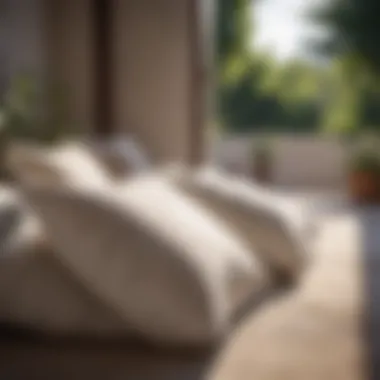
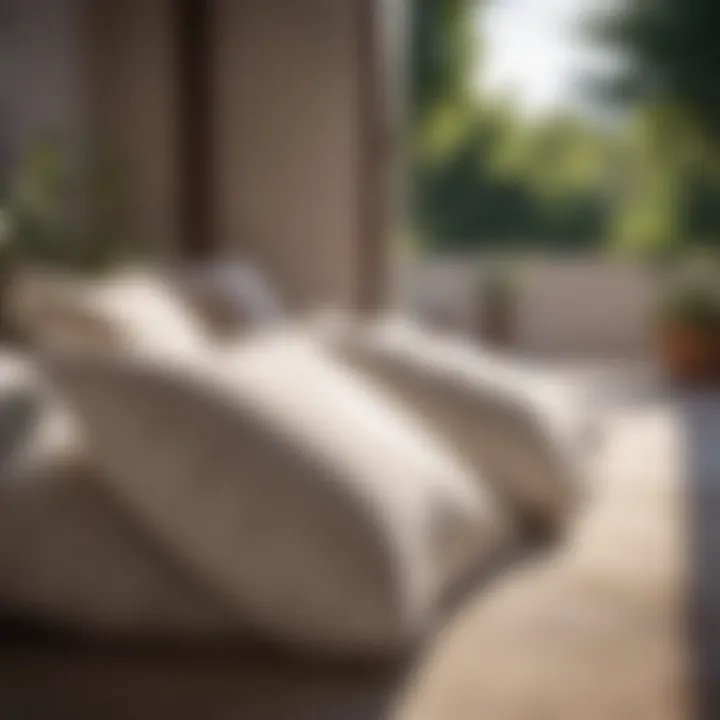
"Properly preparing your down pillows sets the foundation for a successful washing experience."
Removing Pillow Cases and Covers
Before washing, it is crucial to remove all pillow cases and any additional covers. Pillow cases can harbor dust, allergens, and dirt that need to be cleaned regularly to maintain hygiene. This step ensures that the actual pillow gets the most thorough cleaning possible.
In addition, some pillows come with removable covers that may not be made from the same material as the pillow itself. These covers usually come with their own care instructions. Check the labels and follow the guidelines for washing these separately.
Furthermore, taking off the covers allows for better water penetration during washing. This results in a deeper clean, effectively eliminating dirt and bacteria that may have accumulated over time. Remember, skipping this crucial step can lead to uneven cleaning and may affect the pillow's longevity.
In summary, preparing down pillows for washing is more than just a preliminary step; it is an investment in the lifespan and comfort of your bedding. Fluffing and inspecting them, as well as removing covers, are practices that enhance the overall washing process.
Washing Methods
Washing down pillows correctly is crucial for maintaining their structure and longevity. Understanding the appropriate washing methods can significantly influence the comfort and hygiene of your bedding. Down pillows, while comfortable and luxurious, require special care during cleaning. Not all methods may be suitable for down materials, as improper washing can lead to clumping and loss of loft, which diminishes their supportive qualities.
Machine Washing Down Pillows
Choosing the Right Settings
When machine washing down pillows, selecting the right settings is vital. Most machines offer various cycles, and down pillows benefit from gentle washing. Utilize a delicate or gentle cycle to minimize agitation. A cool water temperature is preferred, as hot water can damage the down and fabric. This careful approach helps preserve the integrity of the pillow while ensuring it is thoroughly cleaned.
The key characteristic of choosing the right settings is the balance between effective cleaning and protecting the material. A gentle cycle reduces wear and tear, making it a favorable option. One unique feature to consider is the use of larger washing machines. If possible, opt for a front-loading washer, as it does not have an agitator that can harm pillows. However, many top loaders can work if set to the appropriate cycle.
Recommended Detergents
The choice of detergent plays an essential role when washing down pillows. Look for mild detergents that are free of harsh chemicals and fragrances. These types are less likely to cause irritation to the down and help retain its natural oils, which contribute to softness. Using too much detergent can lead to residue buildup, affecting the pillow's performance.
Recommended detergents often include natural or hypoallergenic options. These detergents not only clean effectively but also ensure that the fibers remain undamaged. Their unique feature is their ability to minimize disruption to the down’s structure while providing sufficient cleaning power. However, avoid the temptation to use fabric softeners, as they can coat the down fibers and reduce fluffiness.
Hand Washing Options
Hand washing down pillows may seem labor-intensive, but it can be a gentle alternative for those concerned about machine wear. Start by filling a large tub or sink with cold water and a small amount of mild detergent. Submerge the pillow, frequently squeezing and pressing to release dirt and oils. Ensure thorough rinsing to eliminate all detergent, as residue can affect fluffiness and hygiene.
Hand washing allows for meticulous care and offers a lower risk of damaging the fillings. However, it requires more time and effort, turning into a labor-intensive process compared to machine washing. For those who cherish their down pillows, this method can be more reassuring.
Drying Down Pillows
Drying down pillows properly is a crucial step in maintaining their shape, functionality, and overall lifespan. The process of drying can directly impact the down filling within the pillows. This is due to the sensitive nature of the down and its ability to clump or lose loft if treated incorrectly. After washing, ensuring that the pillows dry thoroughly not only helps in preserving their fluffiness but also prevents the growth of mildew or odor. Inaccurate drying methods can lead to unsatisfactory sleeping experiences and can shorten the life of your pillows.
Dryer Techniques
Using Dryer Balls
Using dryer balls is a widely recognized technique when drying down pillows. These balls help separate the feathers or down clusters during the drying cycle. By doing this, they can promote air circulation within the pillow, ultimately aiding in a more even drying process. The key characteristic of dryer balls is their ability to reduce drying time and increase the fluffiness of the down.
One advantageous feature of dryer balls is that they often act as an eco-friendly substitute for dryer sheets. They are reusable and can minimize fabric softener use, which many people seek for environmental reasons. However, be cautious; using too many dryer balls can cause the pillows to become overly agitated, which might lead to uneven fluffiness. It is recommended to use only a few with each load.
Tumble Dry Low
Selecting the "tumble dry low" setting on your dryer is another essential aspect of drying down pillows. This setting provides gentle heat that helps to dry the pillows without overexposing them to high temperatures. This is particularly beneficial as high heat can damage the down and the fabric. The key advantage of the tumble dry low method is that it maintains the integrity of both the down filling and the outer fabric.
A unique feature of this setting is that it generally requires a longer drying period. However, the trade-off is worth it for the preservation of quality. It is always advisable to check on the pillows regularly during the drying process to ensure they do not clump. For optimal results, drying pillows in cycles with breaks can further prevent lumping and ensure thorough drying.
Air Drying Considerations
Air drying can be another option for those who prefer to avoid using a dryer. This method can be effective, especially when weather permits. To air dry down pillows, lay them flat in a well-ventilated area away from direct sunlight to avoid damage to the fabric. Flipping and fluffing the pillows further allows for even drying. However, this method requires more time compared to machine drying.
Common Issues After Washing
Understanding the common issues that may arise after washing down pillows is vital for maintaining their quality and longevity. Washing down pillows can effectively remove dust, allergens, and odors. However, improper care during the washing process can lead to problems that diminish the pillows' comfort and functionality. This section covers the two primary issues: clumping of down and loss of loft and support. By being aware of these potential concerns, homeowners and enthusiasts can take steps to mitigate their effects and maintain the pillows in optimal condition.
Clumping of Down
Clumping is a frequent issue encountered after washing down pillows. This problem occurs when the down filling becomes compressed, causing it to bunch together and lose its even distribution within the pillow. Clumping can result in an uneven sleeping surface, adversely affecting comfort and support.
If down clusters together, the pillow loses its ability to contour to the shape of the head and neck. This not only leads to discomfort but can also contribute to neck or back pain. To prevent clumping, it's essential to follow proper washing procedures, including using dryer balls during drying. This helps to break up any clumps that form as the pillow dries, allowing the down to fluff back into its original shape. Regular fluffing of the pillow between washes can also help maintain an even distribution of down fill.
Loss of Loft and Support
Another common issue that arises from washing down pillows is the loss of loft and support. Loft refers to the height and fluffiness of the pillow, which is crucial for providing the necessary support during sleep. When down pillows are washed improperly, they can lose their loft due to excessive washing, insufficient drying, or using the wrong kind of detergent.
A pillow that has lost its loft will not provide adequate support, leading to poor sleep quality. To avoid this situation, always adhere to the care label instructions and avoid fabric softeners, which can coat the down and reduce its ability to expand fully. Proper drying techniques, such as using low heat and ensuring the pillow is completely dry, are critical to maintaining loft. Regularly checking for signs of flattening can also inform homeowners when it might be time to replace their pillows.
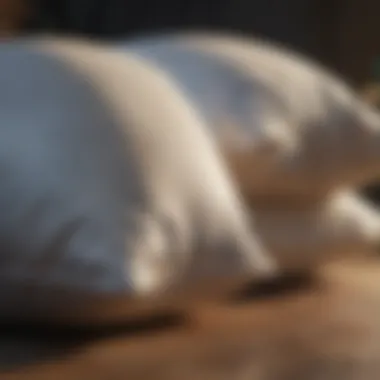
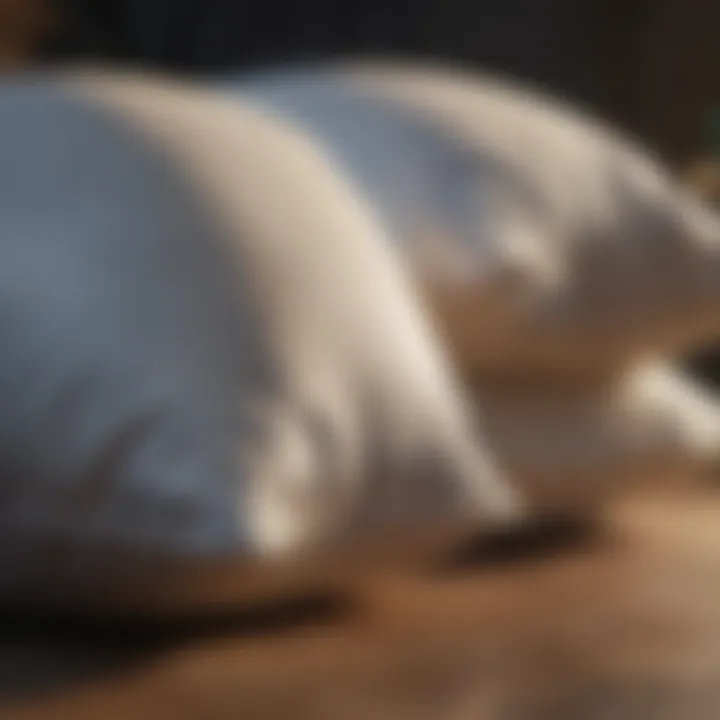
"Maintaining the loft of your down pillow is essential for a good night's sleep. Regular care can prevent the need for earlier replacement."
In summary, while washing down pillows can result in a fresher and cleaner product, improper care may lead to clumping and loss of loft. By understanding these potential issues, one can take proactive measures to ensure that down pillows remain comfortable and supportive. With the right washing and drying techniques, homeowners can extend the lifespan of their down pillows, keeping them both functional and enjoyable.
Tips for Maintaining Down Pillows
Maintaining down pillows requires minimal effort but can significantly extend their lifespan and maintain their comfort. Proper care ensures the pillows remain fluffy, hygienic, and supportive, enhancing your sleep experience. Beyond just periodic washing, regular maintenance practices will help avoid common issues like clumping and loss of loft. This section outlines essential tips for keeping your down pillows in optimal condition.
Regular Fluffing
Fluffing down pillows is crucial to keep them airy and comfortable. When you sleep on a pillow, it compresses under your weight, which can lead to flattening. Regular fluffing helps redistribute the down material, allowing it to regain its natural shape. This simple act can noticeably improve your sleep quality. To fluff your pillow, grasp it by the two ends and gently shake it up and down. This action helps to separate the down clusters, revitalizing the pillow's loftiness.
Moreover, fluffing creates better air circulation within the pillow, minimizing moisture accumulation—a crucial factor in maintaining hygiene. It is advisable to fluff your pillows daily, especially if you notice any signs of denseness.
Using Protective Covers
Investing in quality protective covers can greatly benefit the longevity of your down pillows. Protective covers act as barriers against dust mites, sweat, and allergens. These external layers help maintain cleanliness while significantly reducing the frequency of washing the actual pillow. Choose pillow protectors made from breathable materials, which allow air circulation while offering a layer of defense against environmental factors that can degrade pillow integrity.
When selecting a protective cover, be sure to look for options that are hypoallergenic, which can further reduce allergy symptoms related to dust and mold. It is also wise to wash these covers regularly to ensure they continue to perform their protective function.
"Using a protective cover is a proactive measure that helps keep down pillows fresh and clean, reducing the risk of premature wear."
These practices complement each other, forming a holistic approach to down pillow maintenance that allows you to enjoy their benefits longer.
When to Replace Down Pillows
Assessing when to replace down pillows is crucial for maintaining not just comfort but also hygiene. Down pillows, while designed to last, do wear down over time. Factors like usage, frequency of cleaning, and the quality of materials all impact their longevity. Homeowners must be mindful of these elements to ensure optimal support and cleanliness in their sleeping environment.
Signs of Wear and Tear
Recognizing the signs of wear and tear is essential in determining if a down pillow needs replacement. Here are some indicators:
- Flatness: Over time, down pillows can lose their plushness. If your pillow feels flat and provides little support, it may be time for a new one.
- Clumping: Clumping down can lead to uneven support. If the filling no longer distributes evenly, this can impact sleep quality.
- Odor: Lingering smells can indicate mold or dust mites, which may mean it’s healthier to replace the pillow.
- Allergic Reactions: If you begin to notice an increase in allergies such as sneezing or rashes, it could be due to an older pillow harboring allergens.
Ultimately, if a pillow shows one or more of these signs, it’s likely nearing the end of its usable life.
Recommended Lifespan
It is often recommended that down pillows should be replaced every 2 to 3 years. However, this can vary based on individual usage. For instance, if someone sleeps heavily on their pillow every night or has poor maintenance habits, the lifespan may decrease significantly. In contrast, occasional use can extend longevity.
- Quality Matters: Higher quality down pillows may last longer than cheaper alternatives, potentially offering a different lifespan. Investing in quality can yield better comfort and durability.
- Usage Patterns: If you rotate several pillows or primarily use a pillow for decorative purposes, you may extend the life of each one.
Environmental Considerations
Understanding the environmental impact of down pillows is crucial for both consumers and manufacturers. This section delves into sustainability aspects, ensuring that purchasing decisions align with ethical standards and environmental responsibility. Down, derived from birds, often raises questions about animal welfare and resource usage. Through examining eco-friendly practices and sustainability of down products, individuals can make informed choices.
Sustainability of Down Products
Down is a natural insulator, commonly sourced from ducks and geese. When sourced responsibly, it presents a sustainable option compared to synthetic fibers. Responsible down sourcing involves ensuring that birds are not live-plucked or force-fed, contributing to animal welfare. Certifications like the Responsible Down Standard (RDS) help verify humane treatment in production areas.
Additionally, down products usually have a long lifespan, making them more environmentally friendly when compared to items made from synthetic materials that may take years to decompose.
"Sustainable down production not only protects animal welfare but also supports biodiversity, reinforcing the delicate ecosystem on which these birds depend."
Choosing products with assurance of responsible sourcing helps drive demand for ethical practices and reduces the negative impact on the environment. Purchasing down pillows from reputable brands that prioritize sustainability can contribute to a greener future.
Eco-Friendly Washing Practices
Maintaining down pillows with eco-conscious methods enhances their lifespan while also minimizing environmental impact. Regular washing is needed, yet the methods used can significantly affect the ecosystem. Here are essential practices to consider:
- Use of Mild Detergents: Opt for biodegradable laundry detergents, which break down naturally and do not introduce harmful chemicals into water systems.
- Cold Water Washing: Washing in cold water can save energy. Hot water contributes to higher energy consumption, thus affecting carbon footprints.
- Avoiding Fabric Softeners: These can contain harmful chemicals that are not environmentally friendly. Instead, consider using dryer balls or clean tennis balls in the dryer to maintain loft and fluffiness.
- Air Drying: Whenever possible, air drying is preferable to using electric dryers. It reduces energy consumption and allows for natural drying, which is gentler on down materials.
Incorporating these eco-friendly practices not only protects your investment in down pillows but also plays a significant role in contributing to overall environmental health. By adopting mindful washing routines, consumers can ensure that their bedding choices reflect both comfort and sustainability.
Finale
In this article, we have explored the nuances of washing down pillows, a topic that merits attention for anyone seeking to maintain comfort and hygiene in their sleep environment. The importance of proper care cannot be overstated. Down pillows, known for their softness and insulation, can be a significant investment. Understanding whether they are washable and how to do it correctly impacts their durability and efficiency.
First, we assessed the washability of down pillows. It's essential to remember that not all down pillows share the same care requirements. The fabric, the type of down, and the specific care instructions provided by manufacturers play crucial roles. Hence, checking the care label before proceeding is vital for preserving the integrity of the pillow.
Next, we discussed preparation for washing. Fluffing and inspecting the pillow helps identify any issues, such as tears or worn spots that could worsen during cleaning. Removing pillowcases and covers ensures the pillow itself receives adequate care without additional stress.
The section on washing methods provided clarity on machine and hand washing. Each method has its pros and cons. Machine washing can be more convenient, while hand washing allows for a gentler approach, which may be necessary for delicate pillows. Choosing the right detergent and settings ensures the pillows remain clean without compromising their fill.
Furthermore, drying correctly is a critical stage in the process. Using dryer balls and maintaining low tumble settings help prevent clumping, ensuring that the down retains its loft. Air drying remains an alternative, but it requires more time and specific considerations to avoid dampness or musty odors.
We also addressed common post-washing issues, such as clumping and loss of loft. Awareness of these concerns empowers homeowners to take preventative measures, maintaining the pillows’ shape and usability.
"The right methods for cleaning not only enhance comfort but also promote longevity in down pillows."
By incorporating these practices into your routine, you will ensure that your pillows remain in top condition, ready to provide restful sleep for years to come.







